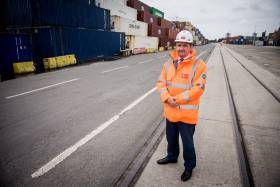Displaying items by tag: New Network Service
Peel Ports Group to Launch Liverpool Rail Container Service
#rail&sail - Peel Ports operators of the Port of Liverpool is set to launch a new rail container service for its customers using the large north-west English port.
The company is in advanced contract discussions with both a rail provider and shippers, with the aim of running the first services before the end of 2017.
It is the first time Peel Ports has offered an integrated package, giving shippers a seamless route to market, from quayside to any UK destination served by major rail lines, or vice versa.
The service was presented during the recent London International Shipping Week (LISW17) hosted at the Lloyds Building by Peel Ports, where leading figures in the UK retail and logistics community will gather to discuss the importance of integration in improving supply chain efficiency.
Peel Ports is also backing calls from Liverpool Metro Mayor Steve Rotheram for significant investment in the Victorian-era rail infrastructure serving the east-west corridor.
Gary Hodgson, Strategic Projects Director, said: “We have long prided ourselves on being more than just a network of ports providing excellent access to markets around the Irish Sea and close to the heart of the UK. This is the next step in our journey to provide shippers with a more integrated, end-to-end answer for their cargo needs. It’s also an important milestone in our evolution as a company and underlines how serious we are about being a genuine partner in the supply chain community.”
He added: “There are generally good connections on routes heading north and south, but cross-country is a real problem. It’s long overdue that the east-west infrastructure was brought into the 21st century so we can expand rail freight usage and reduce the impact of longer-distance road haulage.”
Jerome Wildsmith, Head of Supply Chain at retailer B&M, added: “Good value is at the heart of our consumer offering so a flexible and lean operation is critical to our business model. Routing through the Port of Liverpool has already saved us the equivalent of 4 million road miles, massively cutting our onward transport costs, reducing the carbon emitted and reducing the likelihood of delays on the UK network. We are excited about the possibilities that this new service will provide our business for achieving even more efficiency gains for our growing operation.”
The new service will complement Liverpool’s wider logistics offering, such as multi-user warehousing, as Peel Ports continues its strategy of operating within the wider supply chain sector. The available train path capacity directly to and from the Port of Liverpool is currently amongst the highest of all major ports within the UK, providing expansion options for importers and exporters that also minimise cost, congestion and carbon emissions.
Liverpool is already used to supply biomass to the Drax power station in North Yorkshire via the trans-Pennine route. The port is also within 25 miles of the West Coast Main Line, providing efficient access and journey times to markets in Scotland, the Midlands and the South-east. For intermodal traffic, the port has W10 gauge clearance capability, allowing 9ft 6in containers to be conveyed on standard deck height rail wagons. For further information about the Liverpool rail container service visit our rails services page below.





























































